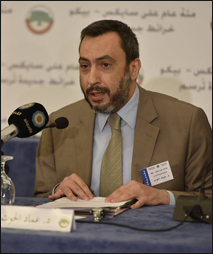 Al-Zaytouna Centre for Studies and Consultations is glad to introduce Dr. Imad al-Hout intervention on “Political and Societal Forces in Bilad al-Sham: Fragmentation or Unity?.”
Al-Zaytouna Centre for Studies and Consultations is glad to introduce Dr. Imad al-Hout intervention on “Political and Societal Forces in Bilad al-Sham: Fragmentation or Unity?.”
This intervention was introduced in the Panel Discussion: “One Hundred Years After Sykes-Picot, New Maps are Being Drawn,” which was conducted by Al-Zaytouna Centre, in Beirut on 26/5/2016.
| Click here to download:
>> Intervention: Political and Societal Forces in Bilad al-Sham: Fragmentation or Unity?… Dr. Imad al-Hout >> Intervention: Political and Societal Forces in Bilad al-Sham: Fragmentation or Unity?… Dr. Imad al-Hout |
Political and Societal Forces in Bilad al-Sham: Fragmentation or Unity?[1] … Dr. Imad al-Hout [2]
The revolutions of the Arab Spring shook the foundations of the Arab order, which was built on a number of authoritarian regimes. The counter-revolution against the Arab Spring exposed the non-homogenous nature of the social fabric of a number of Arab countries, and the fragile relationship between this social reality and the states themselves.
Today, the political regimes of a number of Middle Eastern countries are being eroded, states are collapsing, and societies are fragmenting. Not long ago, religious, ethnic, and tribal communities coexisted peacefully in social environments that resembled mosaics, mostly under an extremely centralized nation-state.
First: The General Political Climate
In the midst of the chaos that seized the Arab republics starting from the year 2011, new maps for the re-partitioning of the Arab Orient began to emerge, in line with the interests of the rival world powers. The positions of the various stakeholders in Bilad al-Sham region (i.e., Syria, Jordan, Palestine and Lebanon) differed over these schemes as follows:
a. Internationally
• On 29/2/2016, the Russian Deputy Foreign Minister Sergei Ryabkov said Syria could become a federal state if that model works in the country.
• Despite the US administration’s public commitment to Syria’s unity and territorial integrity and non-sectarian character, a number of statements hinted at the start of acceptance of partitioning. On 23/2/2016, the US Secretary of State John Kerry spoke about a plan B that could involve a partition of Syria if a planned ceasefire due to start in the next few days does not materialize.
b. Regionally
• On 6/3/2016, Turkey’s Prime Minister Ahmet Davutoğlu stressed that Turkey refuses to divide Syria into mini-states.
• On 24/4/2016, Senior Adviser to Ayatollah Khamenei, Major General Yahya Safavi, declared in a statement to reporters on the sidelines of the National Forum of For Geopolitical Developments in West Asia, that Iran is opposed to the division of Iraq, Syria, and Yemen and said that Iran was seeking to shore up security and the survival of the Syrian political regime.
For his part, Secretary of the Expediency Discernment Council of the System in Iran, Mohsen Rezaee, also warned of a US plot to divide Syria, Iraq, Yemen and other countries in the region.
• On 19/2/2015, Jordan’s King ‘Abdullah II warned that any partition of Syria would create dangerous problems for the Syrian people and the whole region, and would produce fragile entities that pose a security and human burden on Syria’s neighbors and may feed dangerous separatist tendencies in the region.
• On 13/2/2016, the Israeli defense minister Moshe Ya‘alon said on the sidelines of a security conference in Munich that his country stated, “Syria as we knew it will not reunite in the foreseeable future,” and added, “At some stage, I imagine we’ll see enclaves, whether organized or not, of the various groups that are fighting there.” … Read More
***
[1] This intervention was introduced in the Panel Discussion: “One Hundred Years After Sykes-Picot, New Maps are Being Drawn,” which was conducted by Al-Zaytouna Centre, in Beirut on 26/5/2016.
[2] Lebanese MP.



Leave A Comment